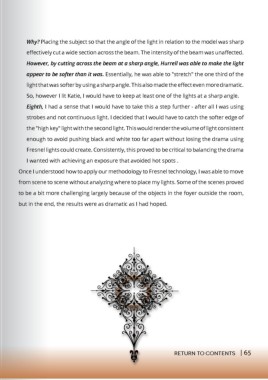Page 65 - Lighting the Un-lightable 2015
P. 65
Why? Placing the subject so that the angle of the light in relation to the model was sharp
effectively cut a wide section across the beam. The intensity of the beam was unaffected.
However, by cutting across the beam at a sharp angle, Hurrell was able to make the light
appear to be softer than it was. Essentially, he was able to "stretch" the one third of the
light that was softer by using a sharp angle. This also made the effect even more dramatic.
So, however I lit Katie, I would have to keep at least one of the lights at a sharp angle.
Eighth, I had a sense that I would have to take this a step further - after all I was using
strobes and not continuous light. I decided that I would have to catch the softer edge of
the "high key" light with the second light. This would render the volume of light consistent
enough to avoid pushing black and white too far apart without losing the drama using
Fresnel lights could create. Consistently, this proved to be critical to balancing the drama
I wanted with achieving an exposure that avoided hot spots .
Once I understood how to apply our methodology to Fresnel technology, I was able to move
from scene to scene without analyzing where to place my lights. Some of the scenes proved
to be a bit more challenging largely because of the objects in the foyer outside the room,
but in the end, the results were as dramatic as I had hoped.
h
Return to Contents | 65

